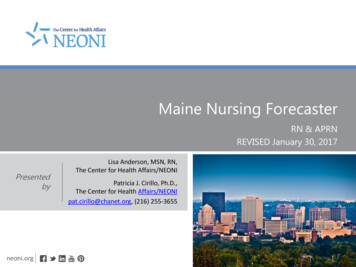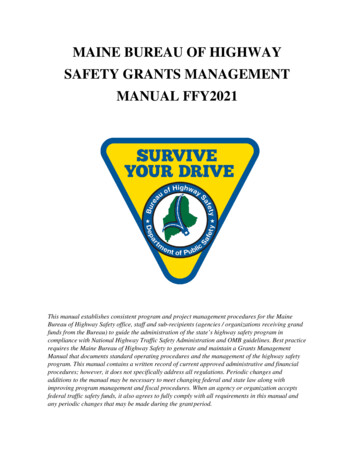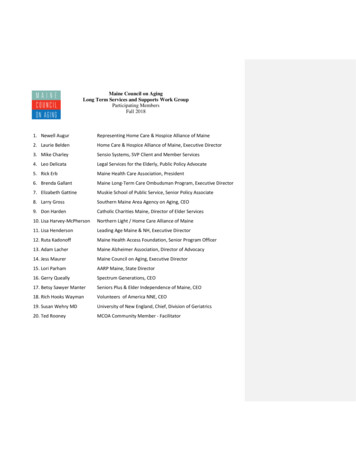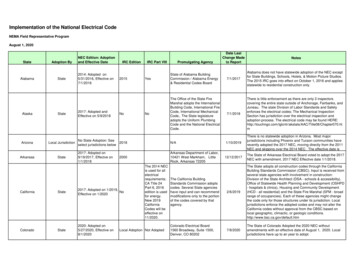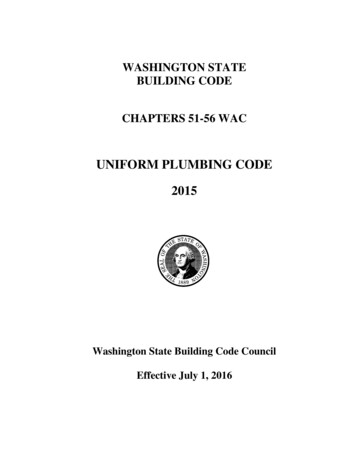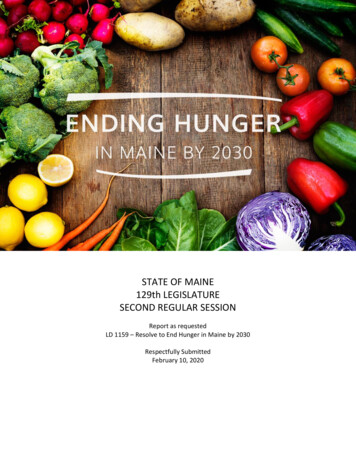
Transcription
STATE OF MAINE129th LEGISLATURESECOND REGULAR SESSIONReport as requestedLD 1159 – Resolve to End Hunger in Maine by 2030Respectfully SubmittedFebruary 10, 2020
STATE OF MAINE129th LEGISLATURESECOND REGULAR SESSIONReport as requestedLD 1159 – Resolve to End Hunger in Maine by 2030Respectfully SubmittedFebruary 10, 2020Advisory Group Members:Amanda BealWalter BeesleyKevin ConcannonPatricia DushuttleKate FreedmanScott HamannJames HannaRep. Craig HickmanEmily HortonKathy Kilrain del RioCraig LapineKristen MialeJo MorrisseyDonna MurrayTheresa OleksiwGinger Roberts-ScottSherri StevensDawud UmmahFrank WertheimCommissioner, Maine Department of Agriculture Conservation and ForestryChild Nutrition Director, Maine Department of EducationAdvisor on Food and Nutrition ProgramsSpecial Projects Manager, Maine Department of Health and Human ServicesFood Programs Director, Healthy AcadiaCase Manager, Knox County Homeless CoalitionExecutive Director, Cumberland County Food Security CouncilHouse Representative & Co-Chair of the Joint Standing Committee on Agriculture,Conservation and Forestry (LD 1159 Sponsor)Director of Policy & Community Engagement, Maine Department of AgricultureConservation and ForestryDirector of Campaigns and Healthcare Advocacy, Maine Equal JusticeFood Security AdvocatePresident, Good Shepherd Food BankProgram Manager, Maine Shared Community Health Needs AssessmentProgram Manager, Maine Senior FarmShare Program, Maine Department ofAgriculture Conservation and ForestryFood Security AdvocateDirector, Maine WIC Nutrition Program, Department of Health and Human ServicesCommunity Relations Manager, Hannaford SupermarketsFood Security AdvocateExtension Educator, Agriculture/Horticulture, University of Maine CooperativeExtensionProject Lead & Other Resources:Penelope JordanEric DayAmy CarringtonProject Lead, Maine Department Agriculture, Conservation and ForestryStudent Intern, University of Southern Maine Food Studies ProgramProgram Specialist, University of Southern Maine Food Studies ProgramENDING HUNGER IN MAINE BY 20302
Table of ContentsContentsTable of Contents . 3Approach . 4Definitions . 6The Nature and Scale of the Problem . 7Ending Hunger in Maine . 13Priority 1 -- Ensure all people have consistent access to healthful, culturally appropriate food. . 13Priority 2 - Address systemic changes by eliminating root causes of hunger and food insecurity. . 14Strategic Plan Development Process . 17Timeline for Creating a Plan and Defining the Path to End Hunger by 2030 . 17Estimated Budget . 20Appendix A – Previous Work to Address Hunger . 21Appendix B - Federal Hunger Relief Programs . 23Appendix C - Good Shepherd Food Bank’s Partner Types by County . 26Appendix D - The Lifelong Impacts of Food Insecurity . 27Appendix E - Food Insecurity Variances by Population . 28Appendix F - Resolve, To End Hunger in Maine by 2030 . 29Sources . 31Endnotes . 33ENDING HUNGER IN MAINE BY 20303
ApproachBy adopting LD 1159 in the 129th State Legislature, which was then signed by Governor Mills, Maine hasembraced a bold vision to end hunger by 2030. This report defines a process through which we cancreate a measurable, achievable, and action-oriented strategic plan for making that vision a reality.As instructed by LD 1159, over the past several months and by using existing resources, the Departmentof Agriculture, Conservation and Forestry has convened, interviewed or otherwise engagedrepresentatives from numerous state departments, non-profits, businesses, and other stakeholders, toinform our understanding of the scope and drivers of hunger in Maine today, and what opportunitiesexist - or need to be developed - to end hunger by 2030. As mandated by LD 1159, this report serves as asummary of that work to date and lays out initial details of the design for a comprehensive strategic planand additional resources needed to carry out a full strategic planning process.This document was developed through interviews, research, and engagement with many people alreadyworking to address hunger and food insecurity across the state. It is intended to provide a high-levelview of the extent of hunger and food insecurity in Maine and the potential systems that seek toaddress these issues.This work began by rooting itself in earlier efforts by various entities in the state to address hunger.Reports and briefs by Maine organizations and agencies covering topics on child hunger, senior hunger,health issues resulting from hunger, homelessness, closing Maine’s meal gap, the importance of federalprograms, and many other related topics were gathered and reviewed (see Appendix A).This process sought to leverage and incorporate the research and good thinking of these many previousefforts. However, the irony is that the same problems surrounding education, jobs, affordable housing,income disparity, chronic health issues, and child and senior hunger are highlighted in each report. Yetwe have not ended hunger. Instead, Maine has seen the expansion of a charitable food system.This process identified over 100 people from across the state currently working to close the gap onhunger and food insecurity. Over 45 of these people sat for individual interviews or were part of largergroup discussions. The intent was to gain a broad understanding of the work happening today, toidentify issues and collect ideas for change, in order to inform a path forward.An Advisory Group made up of representatives of various state departments, organizations, andagencies, and people that have experienced food insecurity met three times. In addition, manymembers were available outside of the formal meetings to provide information, review documents, andoffer insights throughout this process.Research on the role that federal food nutrition programs play in Maine was supported by an internfrom the University of Southern Maine’s Muskie School of Public Policy. Statistics were also gathered bya member of the University of Southern Maine’s Food Studies program staff. The contributions theseindividuals provided were invaluable to this report and the work of the Advisory Group.ENDING HUNGER IN MAINE BY 20304
As we look forward to the next steps toward completing a strategic plan to end hunger by 2030, werecognize the need to dig deeper into our communities and understand how strategies to address ruralhunger may differ from urban strategies. We will need to more fully engage veterans, Tribal members,people experiencing food insecurity, those previously incarcerated, immigrant/refugee, and othermarginalized populations. We need to develop strategies that consider the varied needs of differentpopulations of Maine. We need to gain a firmer understanding of best practices being implemented toaddress near-term food insecurity needs and those that are addressing the more systemic issuessurrounding hunger and food insecurity.We also need to look to other states to learn more about how they are seeking to address the issues ofhunger and food insecurity. In addition, we need to continually recognize that federal programs arevulnerable to political shifts and changes in program eligibility and will need to factor this in as we moveforward in our work to end hunger.ENDING HUNGER IN MAINE BY 20305
DefinitionsDefinitions that guided the development of this report include:Food insecurity: A lack of consistent access to enough food for an active, healthy life (due to) a lack ofavailable financial resources for food at the household level.i (U.S. Department of Agriculture (USDA))Hunger: A personal, physical sensation of discomfort (that may result from food insecurity).ii (USDA)Hunger, End of - The State of Maine is considered hunger-free when the annual USDA food securitymeasure finds for more than two consecutive years that 96% of households in Maine are food secure,and no households are experiencing hunger (subsequently relabeled “very low food security”). Thethreshold is set at 96% because social and economic circumstances are such that some risk of hungerwill always be present as changes in household structure, health conditions, employment situation, andother related circumstances cause interruptions in income, mobility, and access to adequate amounts ofnutritious food.iii (Definition developed by Maine’s Millennium Commission on Hunger and FoodSecurity, 2002)ENDING HUNGER IN MAINE BY 20306
The Nature and Scale of the ProblemHunger is impacting hundreds of thousands of Maine people today and jeopardizing the vitality of ourcommunities and economy for years to come.More than a third of our state’s households subsist with below-livable incomes (Table 1). That meansthey are either actively experiencing or are at-risk for hunger. This includes 40 percent of householdswith seniors, nearly half the households in our most rural counties (Aroostook and Washington), and ashocking twoTable 1 - Maine Households Below Livable Wagethirds of singleparentTotal NumberAbovehouseholds.HouseholdsIn povertypovertyTotalHunger and foodAll Households - Maine (2018)505,82812%24%35%insecurity touchevery communityHouseholds with children113,54612%29%41%across Maine’s 16Households with seniors174,88410%30%40%counties. It isSingle-adult households withestimated thatchildren31,94527%49%76%over 185,000Households without children orpeople (Table 2)seniors218,74913%16%29%across the stateexperience foodHouseholds by County/CtyGroupinginsecurity eachAroostook & Washington39,34819%29%48%day – ourFranklin, Oxford, Piscataquis,neighbors, coSomerset57,63219%25%44%workers, thePenobscot54,38714%31%45%parents, children,Kennebec47,72210%27%37%and teachers inHancock, Knox, Lincoln, Waldo66,97111%23%34%our schools, andAndroscoggin38,67510%29%39%perhaps you asCumberland, Sagadahoc, York201,0939%19%27%well.Source: Maine Center for Economic Policy, Analysis of US Census Bureau, American Community Survey,2018 Public Use Microdata and MIT Living Wage Calculator.Looking outsideof Maine foradditional context, the USDA has ranked our state as having the highest food insecurity rate of all NewEngland states, and records Maine as the 9th most food insecure state in the nation.There are many factors that contribute to food insecurity in Maine: the scarcity of livable-wage jobs,high housing and heating costs,iv an aging population, and high medical costs. Life events, such asdivorce, addiction, job loss, and disability, can be drivers, as well. Appendix E highlights the percent offood insecurity by population demographic.Hunger is a crisis in Maine today. And hunger threatens a thriving and vibrant Maine tomorrow. Hungerimpacts individual well-being and physical health, academic success, and economic advancement, andcan overall impact a community’s ability to thrive.ENDING HUNGER IN MAINE BY 20307
Table 2 identifies the three counties that have the greatest number of people experiencing hunger andfood insecurity, as highlighted in blue (noted with *). The same table also identifies the four countieswith the greatest percentage of people experiencing hunger and food insecurity, as highlighted inorange (or noted with **).The greatest number of those who experience food insecurity live in Cumberland and York Counties(62,369 people). Conversely, 25 percent of Maine’s counties contain over 16 percent of people whoexperience food insecurity. With one in five people experiencing food insecurity, this is a significantimpact on those communities.Viewed in this light, it is no exaggeration to state that hunger knows no bounds in Maine: It impactsyoung and old; lifelong residents and recent arrivals; our most urban and our most rural communities.Table 2 - Food Insecurity by County#%PopulationFoodFoodInsecure InsecureSTATE1,335,907185,922 13.9%COUNTYCumberland *Penobscot *York *KennebecAndroscogginAroostook **Somerset **OxfordHancockWashington **WaldoKnoxFranklinLincolnSagadahocPiscataquis ,7455,1625,5455,0684,2644,3384,3662,751Food insecurity and poverty go hand in hand,and the most direct way to end hunger for asignificant number of people in our state is forthem to have the resources needed to purchasehealthy food and other basics necessities. Thismeans addressing the lack of jobs that provide aliving wage and implementing strategies formaking child-care, healthcare, andtransportation affordable and accessible so allMainers can live vibrant, healthy, and 5%14.2%16.3%13.9%12.7%14.2%12.7%12.3%16.4%The 2019 Maine Shared Community HealthNeeds Assessment State Report identified“Social Determinants of Health” as a priority forthe first time in the collaborative’s history.Specifically, the final report describes foodinsecurity “as a significant concern, especiallyfor youth, low-income families, and olderadults.” The community members who raisedthis issue have witnessed what the research tellsus: those with food insecurity are more likely tohave hypertension, coronary heart disease,hepatitis, stroke, cancer, asthma, diabetes,arthritis, chronic obstructive pulmonary disease,and kidney disease.vSources: maine.gov/cwri 2017 Population; Good ShepherdFood Bank: Food Insecurity by County 2019These health outcomes cost us all in terms of quality of life, lost productivity, and healthcareexpenditures. For instance, food insecurity is a strong predictor of increased emergency room and officevisits, as well as costs associated with ongoing chronic disease management. It is estimated that anindividual who experiences food insecurity incurs an additional 1,863 in health care expendituresannually. Extra healthcare expenditures for those faced with food insecurity dramatically increase for anadult with heart disease ( 5,144), diabetes ( 4,414), or hypertension ( 2,176) when compared to aENDING HUNGER IN MAINE BY 20308
food-secure adult.vi As shown in Table 3, the Maine Center for Economic Policy estimates food insecuritycosts us 629 million in health care services annually.It is not just the hungry who suffer; as a state, we know we need to stimulate economic growth. Yet weinhibit our own successwhen each day thousandsTable 3 - Food Insecurity Costs Maine Millionsof children show up toCategoryCostschool too hungry toHealth care services 629 millionlearn; where thousandsIndirect productivity loss 20 millionof workers are tooSpecial education 19 millioneconomically insecure toLifetime loss of earning, annualized 40 millionthrive; and where millionsTotal 709 millionof healthcare dollars areSources: Maine Center for Economic Policy Issue Brief: Food Insecurity in Maine,being spent on entirelyDecember 2019.preventable effects ofpoverty. This studyestimates the total cost of food insecurity on Maine’s economy at 709 million annually (Table 3) inaddition to the hundreds of millions of public and philanthropic dollars spent on anti-hunger programs.Below is a summary of the federal and charitable programs that currently seek to address the issue ofhunger across Maine.Federal ProgramsThe federal government plays a significant role in addressing food insecurity. There are 15 key federalprograms that target nutrition and food insecurity. Table 4 highlights the federal dollars associated with14 of these programs. See Appendix B for a more detailed description of these programs, including theagencies responsible for administering and overseeing these programs in Maine.Table 4 - Federal Nutrition ProgramsFY 2018 Cost PercentSupplemental Nutrition Assistance Program (SNAP)SNAP-EdSNAP Employment and TrainingMaine Special Nutrition Program for Women, Infants, and Children (WIC)Farmers Market Nutrition Program (FMNP) DHHSSenior Farmers Market Nutrition Program (SFMNP) DACFChild Nutrition ProgramsSummer Food Service Program (SFSP)National School Lunch Program (NSLP)School Breakfast Program (SBP)Fresh Fruit and Vegetable Program (FFVP)Community Food Systems (CFS)Child and Adult Care Food Program (CACFP)Food Distribution Programs / USDA FoodsCommodity Supplemental Food Program (CSFP)The Emergency Food Assistance Program (TEFAP) 218,217,647 3,893,706 686,998 19,038,661 75,000 943,42971.36%1.27%0.22%6.23%0.02%0.31% 2,169,829 33,862,711 12,783,406 1,946,984 100,000 8,861,1270.71%11.07%4.18%0.64%0.03%2.90%Total 305,789,593Source: FNS Data Tables, https://www.fns.usda.gov/data-researchENDING HUNGER IN MAINE BY 20309 2,021,4311,188,6640.39%0.66%
The most significant federal program is the Supplemental Nutrition Assistance Program (SNAP),previously known as “Food Stamps.” SNAP is our nation’s most effective anti-hunger program and, inMaine, accounts for over 218 million (71.3 percent) of federal food assistance. SNAP is used by singlemothers, seniors, the disabled, children, people who are employed, and many others. The USDA statesthat over 167,800 people receive SNAP benefits in Maine, which includes more than 89,200 householdsand equates to over 62.4 million meals.vii SNAP benefits provide an average of three dollars and fiftycents ( 3.50) per person per day, which many argue is not adequate to provide nutritional meals. Asurvey of food pantry clients conducted by Good Shepherd Food Bank and Preble Street in 2017 foundthat, on average, SNAP benefits run out between day one and day fifteen the month the benefit isreceived. Even with the significant dollars from SNAP, 37 percent of our food-insecure residents do notqualify for SNAP.viiiIn Maine, SNAP is administered by the Department of Health and Human Services. While the USDAprovides much guidance and rules on how the program is administered, states have some flexibility thatimpacts the program’s accessibility and eligibility. This is an area of opportunity when considering howto end hunger in Maine.SNAP has many advantages over charitable food programs. It does not depend on a separatedistribution system, people are able to access food at most any grocery outlet, and they are allowed thedignity to make their own food choices. SNAP has a significant impact on food insecurity, which can becomplemented with education on budgeting, food purchasing, and cooking.SNAP also has an economic impact on communities across Maine. According to the Maine Center forEconomic Policy, it is estimated that for every SNAP dollar spent, there is a multiple effect equivalent of 1.73 of economic activity impact.ix Using this multiplier means that Maine’s 218 million in annualSNAP benefits accounts for over 370 million in total economic impact. In 2018, SNAP accounted for 6percent of all grocery store sales in the state. In some 218 million in SNAP benefitscounties, it played an even greater role; in Somersetequals over 370 million in totalCounty, SNAP spending accounted for 18 percent of alleconomic impact.grocery store sales; in Androscoggin and Oxford Counties,13 percent of all grocery store sales were paid for withSNAP dollars.xAnother federal program—the Special Supplemental Nutrition Program for Women, Infants, andChildren (WIC)-- is for pregnant and breastfeeding women and children up to age five and works toensure healthy children, both cognitively and physically. The WIC program recognizes that a child’shealth needs start early (see Appendix D). The WIC program has been proven to reduce low birth weightand preterm labor. xi In Maine, WIC is administered by the Department of Health and Human Services.Once children are entering school, there are school nutrition programs that ensure students are fed andready to learn. The six federal child nutrition programs identified in Table 4 seek to ensure that childrenhave access to breakfast, lunch, snacks, after school meals, and summer programs that provide meals. InMaine, the school nutrition programs and the Child and Adult Care program are all administered by theDepartment of Education. Like SNAP, these programs have guidelines and rules set by the USDA.However, state policies and local district initiatives can have a significant impact on eligibility, asevidenced by the wide disparity in participation rates for these programs across school districts inENDING HUNGER IN MAINE BY 203010
Maine. In January 2015, the Task Force to End Student Hunger delivered their report to the 126thLegislature outlining actions needed to address child hunger. This resulted in a focus on leveragingfederal dollars and expanding programs to include snack, after school, and summer nutrition programs;however, expansion in this area still presents a significant opportunity to address hunger in Maine.The USDA provides funding for two direct food programs: The Emergency Food Assistance Program(TEFAP) and the Commodity Supplemental Food Program (CSFP). TEFAP is for qualified, low-incomefamilies. CSFP is for qualified, low-income seniors. For both programs, food is purchased by the USDAand shipped to states to be distributed to qualified families. In Maine, the Department of Agriculture,Conservation, and Forestry administers both programs and contracts with Good Shepherd Food Bank tomanage the warehousing and distribution aspects for most of the programs. For both programs,community partners, including food pantries and the Area Agencies on Aging, perform the directdistribution of the food to the recipients.Meals on Wheels is managed through the Department of Health and Human Service’s Maine Office ofAging and Disability Services. Seniors (60 ) and individuals with disabilities receive nutritious homedelivered meals by a volunteer who visits and performs a safety check. Priority is given to those with thegreatest social and economic need. There are over 400 people on the waitlist at any given time. The costof this program for 2019 was over 1.6 million (federal, state, local, and private dollars) for almost fivethousand homebound participants.xiiThe Maine Department of Corrections (DOC), in coordination with the University of Maine CooperativeExtension, offers a Master Gardener program to inmates. Participants in this program not only learntransferable skills, but they grow food for the prison kitchens, as well as food pantries in the surroundingareas. The DOC is seeking to expand food production and processing, and thus move more food to thefood pantries.ENDING HUNGER IN MAINE BY 203011
Charitable ProgramsAs large and robust as the federal response to hunger has sometimes been, it has not kept pace with theneed. In response,charitable foodTable 5 - Meal Gap by Countyprograms emerged inCountyMealsMealsRemaining % Meal Gap % Meal GapNeededProvided byMeal GapRemainingMetthe early 1980s. TheGSFBcharitable hungerNetworkmodel relies on %banks to source olumes of ) food and bute that food grams ,533,8711,111,722422,14827.5%72.5%commonly pantries) to hand tly to food ople in ington1,140,661927,391213,27018.7%81.3%Established in 1981,York3,359,5932,376,107983,48629.3%70.7%Good Shepherd FoodGrand Total33,698,45722,840,15510,858,30232.2%67.8%Bank (GSFB) is Maine’sSource: Good Shepherd Food Bank December 2019only food bankoperating on astatewide basis. GSFB partners with Catholic Charities Food Bank to serve Aroostook County. GSFB’snetwork includes 254 food pantries, 88 health care programs, and 126 school-based food pantries (seeAppendix C for breakdown by type and county). In addition, there are several food pantries known tooperate outside of the GSFB network. Foodpantries.org estimates there are over 290 food pantries inMaine, and Maine food security advocates speculate that this number may be low. All of these programsare working to address hunger and food insecurity affecting 185,000 people across all of Maine’s 16counties. Even after the federal programs, there remains a meal gap of over 33 million meals annually.Charitable programs are currently only meeting 68 percent of the gap, leaving a gap of over 10 millionmeals annually.The current system for addressing hunger is absolutely necessary and by and large effective in achievingwhat it sets out to do: making sure vulnerable Maine people have some food on the table. However, itsuffers from a number of shortcomings: It is focused nearly entirely on the symptom of hunger rather than its root causes. The public/charitable patchwork is not well coordinated. The charitable system is dependent on philanthropic giving, which makes it vulnerable toeconomic variables.Developing a strategic plan for ending hunger will allow Maine to unify its efforts around data-drivenbest practices, and leverage these practices in a collaborative and measurable way. Hunger is not aresult of individual choices but a product of an underperforming political and economic system. It’s timefor a coordinated, results-based plan to end hunger in Maine.ENDING HUNGER IN MAINE BY 203012
Ending Hunger in MaineEnding hunger in Maine by 2030 requires a broad, long-range approach. Providing hunger relief today,as currently designed, will not end hunger tomorrow. To truly eliminate hunger in Maine, the AdvisoryGroup suggests a multi-sector approach aimed at addressing its root causes.The time is right. The recent publication of the Maine Economic Development Strategy 2020 - 2029, therevival of the Children’s Cabinet, the Maine Shared Community Health Needs Assessment placing foodinsecurity as a priority issue, the push for comprehensive, high-quality childcare, and the focus onhousing needs are all evidence that Maine is ready to look at how to address the underlying issues offood insecurity. We must harness this energy and look for opportunities to ensure that food insecurityand poverty are considered by all relevant stakeholders when enacting policies. Working together is theonly way we will have a lasting impact on this complex issue.The Advisory Group strongly recommends that the development of a comprehensive strategic planincorporate two overarching priorities as a starting point: the first priority focusing on meetingimmediate needs, and the second on addressing systemic changes that will solve hunger longer term.These two proposed priorities, along with six strategy areas, are outlined on the following pages. Inaddition, the Advisory Group has been assembling a robust list of candidate actions that were identifiedover the past several months, some of which are included below as bulleted items, that will be testedand vetted as part of the broader strategic planning work. While not every strategy area directly putsfood on someone’s plate, together, they could lead to greater self-reliance and independence,diminishing the need for safety net programs over time.Priority 1 -- Ensure all people have consistent access to healthful, culturallyappropriate food.Leveraging existing federal programs plays a significant role in alleviating foodinsecurity in the near-term.1 - Provide Consistent Access to Healthful, Culturally Appropriate FoodThis priority area has a near-term and long-term focus. The near-term focus considers opportunities toaddress the current meal gap in Maine by leveraging federal programs. The long-term focus continues toassess opportunities regarding federal programs and, at the same time, to identify opportunities to alignmore services to the charitable food system (e.g., budgeting, advocacy training, job training).The Advisory Group identified several near-term actions that could be developed into targetedstrategies, including: Seeking ways to maximize federal programs for seniors, minorities, children, families, andothers. Increasing participation in key federal nutrition programs by working to remove barriers, andenhancing outreach for programs suc
orange (or noted with **). The greatest number of those who experience food insecurity live in Cumberland and York Counties (62,369 people). Conversely, 25 percent of Maine's counties contain over 16 percent of people who . The 2019 Maine Shared Community Health Needs Assessment State Report identified "Social Determinants of Health" as .
